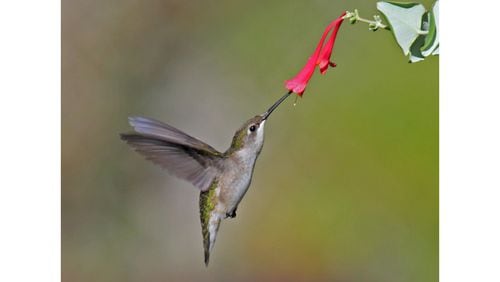In a couple of weeks, ruby-throated hummingbirds will begin arriving in Georgia for their nesting season after overwintering in Mexico and Central America.
That means many of us homeowners will be filling up our nectar feeders and sprucing up flower beds to provide sugary nectar for the new arrivals. That’s important, because the little birds will need copious amounts of the sweet liquid for quick energy to begin nesting.
That hummingbirds evolved to feed on nectar is evident by their long bills and tongues. Some scientists believe that as many as 19 species of native plants found in the eastern United States co-evolved with hummingbirds to take advantage of the birds’ feeding habits. Most of the plants have tubular-shaped flowers that seem designed to accommodate a hummingbird’s bill.
By offering nectar to hummingbirds, the plants get pollinated in return. A good example is the common, reddish-orange trumpet creeper that begins blooming in May. The bird plunges its bill into a bloom to lap up the nectar and, in the process, picks up pollen that gets transferred to other flowers.
Hummingbirds, however, need more than nectar to thrive: They also need a variety of small insects and arachnids — mites, mosquitoes, aphids, small bees, gnats, small spiders and the like. Some scientists say a typical ruby-throat diet during nesting season may be 50%-60% insects.
Doug Tallamy, a renowned native plant authority, says the percentage may be higher: “Hummingbirds like and need nectar but 80% of their diet is insects and spiders.” (Spiderwebs also are vital components of hummingbird nests.)
Mother hummingbirds feed their young almost exclusively on small insects and spiders to provide protein for the babies’ growth. Insects also provide essential vitamins, minerals, oils and fats that the birds don’t get from nectar.
So, if you want more hummingbirds in your yard, consider planting native, nectar-producing flowers that also attract small insects. Examples include wild columbine, obedient plant and New Jersey tea. Keep your nectar feeders clean and full, too.
IN THE SKY: From David Dundee, Tellus Science Museum astronomer: The moon will be new on Sunday. Venus and Mars are very low in the east just before sunrise. Jupiter is in the west at sunset and will appear near the moon Wednesday night.
Charles Seabrook can be reached at charles.seabrook@yahoo.com.
About the Author






